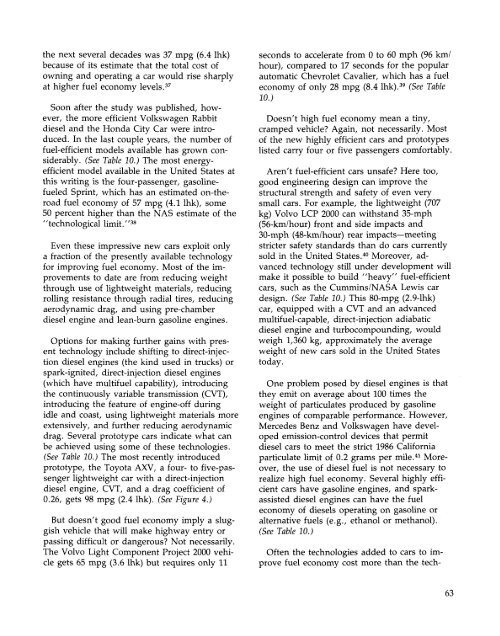ENERGY FOR A SUSTAINABLE WORLD - World Resources Institute
ENERGY FOR A SUSTAINABLE WORLD - World Resources Institute
ENERGY FOR A SUSTAINABLE WORLD - World Resources Institute
You also want an ePaper? Increase the reach of your titles
YUMPU automatically turns print PDFs into web optimized ePapers that Google loves.
the next several decades was 37 mpg (6.4 lhk)<br />
because of its estimate that the total cost of<br />
owning and operating a car would rise sharply<br />
at higher fuel economy levels. 37<br />
Soon after the study was published, however,<br />
the more efficient Volkswagen Rabbit<br />
diesel and the Honda City Car were introduced.<br />
In the last couple years, the number of<br />
fuel-efficient models available has grown considerably.<br />
(See Table 10.) The most energyefficient<br />
model available in the United States at<br />
this writing is the four-passenger, gasolinefueled<br />
Sprint, which has an estimated on-theroad<br />
fuel economy of 57 mpg (4.1 lhk), some<br />
50 percent higher than the NAS estimate of the<br />
"technological limit." 38<br />
Even these impressive new cars exploit only<br />
a fraction of the presently available technology<br />
for improving fuel economy. Most of the improvements<br />
to date are from reducing weight<br />
through use of lightweight materials, reducing<br />
rolling resistance through radial tires, reducing<br />
aerodynamic drag, and using pre-chamber<br />
diesel engine and lean-burn gasoline engines.<br />
Options for making further gains with present<br />
technology include shifting to direct-injection<br />
diesel engines (the kind used in trucks) or<br />
spark-ignited, direct-injection diesel engines<br />
(which have multifuel capability), introducing<br />
the continuously variable transmission (CVT),<br />
introducing the feature of engine-off during<br />
idle and coast, using lightweight materials more<br />
extensively, and further reducing aerodynamic<br />
drag. Several prototype cars indicate what can<br />
be achieved using some of these technologies.<br />
(See Table 10.) The most recently introduced<br />
prototype, the Toyota AXV, a four- to five-passenger<br />
lightweight car with a direct-injection<br />
diesel engine, CVT, and a drag coefficient of<br />
0.26, gets 98 mpg (2.4 lhk). (See Figure 4.)<br />
But doesn't good fuel economy imply a sluggish<br />
vehicle that will make highway entry or<br />
passing difficult or dangerous? Not necessarily.<br />
The Volvo Light Component Project 2000 vehicle<br />
gets 65 mpg (3.6 lhk) but requires only 11<br />
seconds to accelerate from 0 to 60 mph (96 km/<br />
hour), compared to 17 seconds for the popular<br />
automatic Chevrolet Cavalier, which has a fuel<br />
economy of only 28 mpg (8.4 lhk). 39 (See Table<br />
10.)<br />
Doesn't high fuel economy mean a tiny,<br />
cramped vehicle? Again, not necessarily. Most<br />
of the new highly efficient cars and prototypes<br />
listed carry four or five passengers comfortably.<br />
Aren't fuel-efficient cars unsafe? Here too,<br />
good engineering design can improve the<br />
structural strength and safety of even very<br />
small cars. For example, the lightweight (707<br />
kg) Volvo LCP 2000 can withstand 35-mph<br />
(56-km/hour) front and side impacts and<br />
30-mph (48-km/hour) rear impacts—meeting<br />
stricter safety standards than do cars currently<br />
sold in the United States. 40 Moreover, advanced<br />
technology still under development will<br />
make it possible to build "heavy" fuel-efficient<br />
cars, such as the Cummins/NASA Lewis car<br />
design. (See Table 10.) This 80-mpg (2.9-lhk)<br />
car, equipped with a CVT and an advanced<br />
multifuel-capable, direct-injection adiabatic<br />
diesel engine and turbocompounding, would<br />
weigh 1,360 kg, approximately the average<br />
weight of new cars sold in the United States<br />
today.<br />
One problem posed by diesel engines is that<br />
they emit on average about 100 times the<br />
weight of particulates produced by gasoline<br />
engines of comparable performance. However,<br />
Mercedes Benz and Volkswagen have developed<br />
emission-control devices that permit<br />
diesel cars to meet the strict 1986 California<br />
particulate limit of 0.2 grams per mile. 41 Moreover,<br />
the use of diesel fuel is not necessary to<br />
realize high fuel economy. Several highly efficient<br />
cars have gasoline engines, and sparkassisted<br />
diesel engines can have the fuel<br />
economy of diesels operating on gasoline or<br />
alternative fuels (e.g., ethanol or methanol).<br />
(See Table 10.)<br />
Often the technologies added to cars to improve<br />
fuel economy cost more than the tech-<br />
63

















